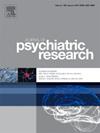重性抑郁症循环神经胶质细胞系来源的神经营养因子水平的最新荟萃分析:澄清病例对照差异和治疗效果
IF 3.2
2区 医学
Q1 PSYCHIATRY
引用次数: 0
摘要
重度抑郁症(MDD)是导致残疾的重要原因,神经胶质细胞系来源的神经营养因子(GDNF)在其机制中起着至关重要的作用。以往关于重度抑郁症患者循环GDNF水平的研究结果并不一致。本荟萃分析旨在通过量化病例对照差异和评估治疗对GDNF调节的影响,阐明循环中GDNF水平与MDD之间的关系。方法对21项病例对照研究进行荟萃分析,共纳入2524名受试者,其中包括1262名重度抑郁症患者和1262名健康对照,以及两项干预研究,共纳入355名受试者。比较两组间的GDNF水平,评估治疗前后的变化。采用随机效应模型来适应高异质性,meta回归和亚组分析检验了年龄、性别比例、抑郁严重程度和方法因素等调节因素的影响。结果MDD患者的gdnf水平显著低于健康对照组(d = - 0.78, p = 0.001),具有高度异质性,但无显著发表偏倚。在接受治疗的患者、重度抑郁症患者(HDRS >19)和老年患者中,GDNF减少最为明显。MDD患者血清GDNF水平明显较低,而血浆水平无显著差异。元回归发现女性性别比例是GDNF水平的显著调节因子。治疗干预显著增加GDNF水平(d = 0.23, p = 0.035),异质性低。结论MDD患者外周血GDNF水平降低,经治疗后升高。这些发现支持GDNF作为重度抑郁症的生物标志物和治疗靶点的能力。本文章由计算机程序翻译,如有差异,请以英文原文为准。
Updated meta-analysis of circulating glial cell line-derived neurotrophic factor levels in major depressive disorder: Clarifying case-control differences and treatment effects
Background
Major depressive disorder (MDD) is a significant cause of disability, and glial cell line-derived neurotrophic factor (GDNF) plays a crucial role in its mechanisms. Previous findings on circulating GDNF levels in MDD have been inconsistent. This meta-analysis aims to clarify the relationship between GDNF levels in circulation and MDD by quantifying case-control differences and evaluating the impact of treatment on GDNF modulation.
Methods
A meta-analytic review was conducted involving 21 case-control studies with 2524 participants, including 1262 MDD patients and 1262 healthy controls, along with two intervention studies comprising 355 participants. GDNF levels were compared between the two groups, assessing pre- and post-treatment changes. A random-effects model was used to accommodate high heterogeneity, and meta-regression and subgroup analyses examined the influence of moderators such as age, sex ratio, depression severity, and methodological factors.
Results
GDNF levels were significantly lower in MDD patients compared to healthy controls (d = −0.78, p = 0.001), with high heterogeneity but no significant publication bias. GDNF reductions were most pronounced in treated patients, those with severe depression (HDRS >19), and older patients. Serum GDNF levels were considerably lower in MDD patients, while plasma levels showed no significant difference. Meta-regression identified the female sex ratio as a significant moderator of GDNF levels. Therapeutic interventions significantly increased GDNF levels (d = 0.23, p = 0.035) with low heterogeneity.
Conclusion
Circulating GDNF levels are decreased in MDD patients, and increased by treatment. These findings support GDNF's capability as both a biomarker and therapeutic target for MDD.
求助全文
通过发布文献求助,成功后即可免费获取论文全文。
去求助
来源期刊

Journal of psychiatric research
医学-精神病学
CiteScore
7.30
自引率
2.10%
发文量
622
审稿时长
130 days
期刊介绍:
Founded in 1961 to report on the latest work in psychiatry and cognate disciplines, the Journal of Psychiatric Research is dedicated to innovative and timely studies of four important areas of research:
(1) clinical studies of all disciplines relating to psychiatric illness, as well as normal human behaviour, including biochemical, physiological, genetic, environmental, social, psychological and epidemiological factors;
(2) basic studies pertaining to psychiatry in such fields as neuropsychopharmacology, neuroendocrinology, electrophysiology, genetics, experimental psychology and epidemiology;
(3) the growing application of clinical laboratory techniques in psychiatry, including imagery and spectroscopy of the brain, molecular biology and computer sciences;
 求助内容:
求助内容: 应助结果提醒方式:
应助结果提醒方式:


